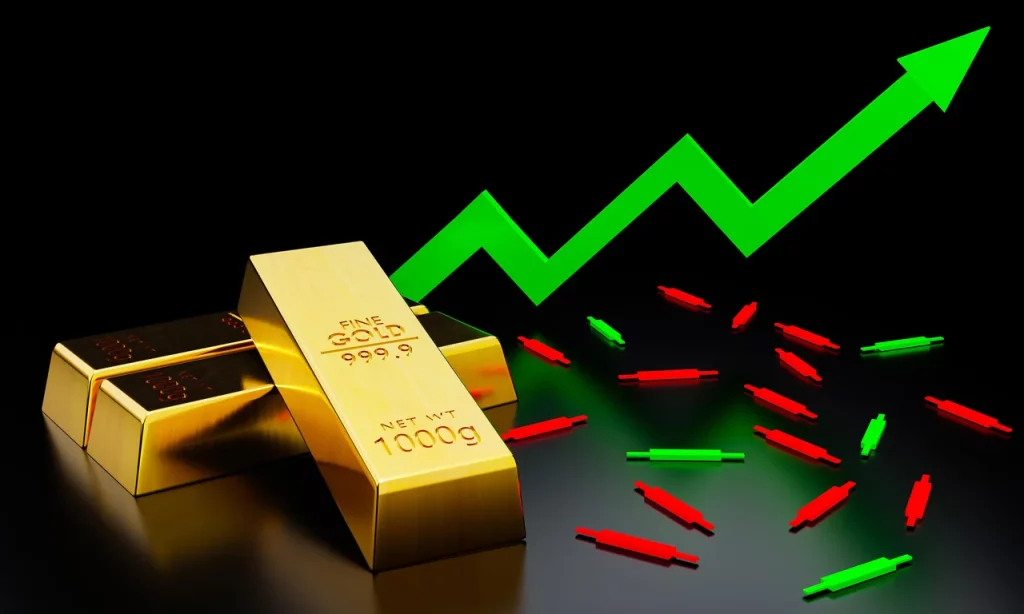Introduction: Understanding Gold’s Role as a Safe Haven Asset
Gold has long been considered a safe haven asset—a reliable store of value that holds its worth in times of economic uncertainty. Over the centuries, gold has weathered financial crises, wars, inflationary periods, and political turmoil, cementing its reputation as a crisis commodity. However, with the rise of new financial instruments, emerging markets, and digital assets, the role of gold in modern investing has come under scrutiny.
This article explores whether gold still holds its status as a safe haven by analyzing 100 years of data. From its performance during inflationary periods to its resilience in the face of global recessions and wars, we will delve into how gold has historically behaved under various global risk events. We will also examine its performance against emerging market trends and explore data-backed analysis to help modern investors decide whether gold remains a must-have asset in today’s diversified portfolio.
Long-Term Correlation Between Gold and Global Risk Events
Over the last century, gold has displayed a strong correlation with global risk events, including wars, economic depressions, and major political upheavals. The historical data on gold’s performance during these events offers valuable insights for investors today.
- Gold During Wars and Political Uncertainty
The most evident correlation between gold and global risk events can be seen in times of war and political instability. During the First and Second World Wars, gold prices remained relatively stable or even surged as investors sought refuge from the volatility in traditional financial markets.
For instance, during World War II, despite various governments setting gold prices at fixed values (particularly during the gold standard era), gold continued to be used as a form of wealth preservation across borders. Post-war inflation in the 1970s also saw gold surge in value as central banks struggled with high inflation rates.
In more recent times, geopolitical tensions such as the Gulf War in the early 1990s and the ongoing instability in regions like the Middle East have often led to increased demand for gold. This correlation suggests that when global risks intensify, investors flock to gold as a hedge against the unpredictability of fiat currencies and equity markets.
- Gold During Inflationary Periods
Gold has a long-standing reputation as a hedge against inflation. Historical data supports this assertion, as gold tends to retain its purchasing power during periods of high inflation. One of the most notable periods of gold’s performance during inflation was the 1970s. As the U.S. faced soaring inflation rates, with the consumer price index (CPI) rising to over 13% in 1979, gold saw a dramatic price increase.
In fact, from 1971 to 1980, when the Bretton Woods system was dismantled and the dollar was no longer backed by gold, gold prices skyrocketed from under $40 per ounce to over $850 per ounce—an increase of more than 2,000%. Investors flocked to gold during this time as the dollar weakened and inflation eroded the value of traditional savings.
- Gold During Recessionary Periods
Historically, gold has shown itself to be a resilient asset during periods of recession. During the Great Depression (1929-1939), gold’s value remained relatively stable, as the gold standard was still in effect in many parts of the world. While global economies collapsed and stock markets suffered massive losses, gold acted as a stabilizing force.
Similarly, during the 2008 global financial crisis, gold prices initially fell as investors liquidated assets to cover margin calls and reduce exposure to riskier investments. However, as the crisis deepened and central banks slashed interest rates, gold quickly rebounded, climbing to new highs as a store of value amidst massive fiscal and monetary stimulus.
This demonstrates that while gold’s behavior during recessions may vary in the short term, its long-term ability to retain value during economic downturns has been a consistent feature.
Performance Comparison: Gold vs. Emerging Markets
As global markets evolve, particularly with the rise of emerging markets, many investors have questioned whether gold’s traditional role as a safe haven still holds true. With the rapid growth of emerging economies in Asia, Africa, and Latin America, many investors have shifted their attention to these markets in search of higher returns. So, how does gold compare to emerging market investments?
- Gold vs. Emerging Market Stocks
In times of geopolitical uncertainty or economic crisis, emerging market stocks often exhibit higher volatility than developed market equities. For instance, during the 2008 financial crisis, many emerging markets experienced substantial losses, while gold prices continued to rise. This behavior can be attributed to the fact that emerging markets are often more sensitive to global economic conditions, making them riskier than gold during times of uncertainty.
However, in periods of economic stability, emerging markets have historically outperformed gold in terms of returns. For example, from 2000 to 2007, the period of strong global economic growth, emerging market equities, particularly in Asia, delivered substantial returns, far outpacing the performance of gold.
- Gold vs. Emerging Market Bonds
Gold also stands in contrast to emerging market bonds, which are generally more sensitive to interest rate fluctuations and credit risk. In times of economic stability and growth, emerging market bonds can provide attractive yields, making them an appealing alternative to gold. However, during periods of economic instability or rising inflation, these bonds can underperform, while gold continues to hold its value.
For example, during the early 2010s, when the U.S. was in the midst of a prolonged economic recovery, emerging market bonds offered higher yields than gold, which saw a pullback. Yet, as inflationary pressures and geopolitical tensions rose in the latter part of the decade, gold prices climbed, while emerging market bonds became more volatile.

Data-Backed Trend Analysis for Modern Investors
When evaluating gold as a safe haven for modern investors, it is essential to analyze trends that are backed by data. This section explores how gold has performed in the context of various economic and geopolitical scenarios and how investors can use historical data to make more informed decisions today.
- Correlation with U.S. Dollar Strength and Global Risk Sentiment
The price of gold has traditionally had an inverse relationship with the strength of the U.S. dollar. When the dollar weakens, gold prices tend to rise, and vice versa. The reason for this inverse relationship is that gold is priced in U.S. dollars, and when the dollar loses value, it takes more dollars to buy the same amount of gold.
Over the last 100 years, this correlation has remained consistent. For example, during periods when the U.S. dollar was devalued, such as after the collapse of the Bretton Woods system in 1971, gold prices surged. Conversely, during times when the U.S. dollar strengthened—such as in the 1980s during the Volcker-led Federal Reserve tightening—gold prices faced significant corrections.
- Performance During Economic Stimulus and Central Bank Actions
In the modern era, central bank actions, particularly monetary stimulus programs and interest rate cuts, have become major drivers of gold prices. During times of economic uncertainty, when central banks lower interest rates or implement quantitative easing (QE) programs, gold prices often rise as investors seek alternatives to low-yielding bonds and cash.
For example, after the 2008 financial crisis, gold saw a significant rise as central banks across the world, particularly the U.S. Federal Reserve, implemented massive QE programs. More recently, in response to the COVID-19 pandemic, central banks once again slashed interest rates and initiated stimulus packages, leading to another surge in gold prices.
- Emerging Threats: Digital Assets and Cryptocurrencies
With the rise of digital assets like Bitcoin, many investors have questioned whether gold can maintain its safe-haven status in the face of technological innovation. Cryptocurrencies, which have been marketed as alternative stores of value, have gained significant traction in recent years.
While the rise of cryptocurrencies has added a new dimension to the investment landscape, data shows that gold still remains the primary safe-haven asset for investors during times of economic uncertainty. Gold’s long history of value retention, its tangible nature, and its lack of counterparty risk differentiate it from digital currencies, which are still in the early stages of adoption and face regulatory challenges.
Conclusion: Is Gold Still a Safe Haven in 2025?
Based on 100 years of data, gold continues to be a reliable safe-haven asset during times of global economic uncertainty, geopolitical risk, inflationary pressures, and financial market volatility. While emerging markets and digital assets like cryptocurrencies offer promising returns in periods of stability and growth, gold remains unmatched in its ability to preserve wealth during times of crisis.
For modern investors, gold remains a critical component of a diversified portfolio. It is especially relevant during periods of heightened geopolitical instability, inflationary risk, and central bank interventions. However, investors should not rely solely on gold as a hedge; instead, they should consider integrating it with other assets like equities, bonds, and real estate to mitigate risks and capture returns in different market conditions.



































